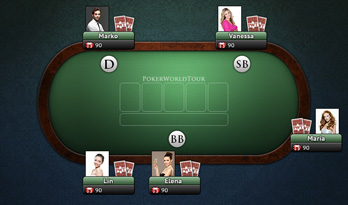Poker Rules (Texas Hold'Em)
"Learning to play (Poker) [...] is worth about as much as a college education [...]".
Mark Twain
Poker in General
- Poker is about winning chips from other players.

- The player with the best poker card combination wins the chips.
- Excitement, surprise and strategy define poker.
- Poker is exciting, because two cards are kept secret until the end.
- Surprise comes from five cards that are randomly chosen and placed in the open.
- Strategy is required to place bets and evaluate opponents actions.
The unique combination of strategy and luck makes poker equally suitable for beginners and professionals.
Texas Hold’em Poker
The most popular poker variation is called Texas Hold’em Poker. The rules are short and easy to learn.
Game Setup
Texas Hold’em Poker requires at least 2 players and is usually played with up to 10 players at each table. In order to join the game each player has to render a buy-in. This initial capital is represented by chips and needs to be paid by all players. It is visible to all players at the table.
 Before the first game starts a Dealer is chosen. He will deal the cards clockwise and the game proceeds clockwise as well. The two players on the dealers left hand side need to pay the so called Blinds. Blinds ensure that the winner of each game wins at least some chips in terms of the blinds.
Before the first game starts a Dealer is chosen. He will deal the cards clockwise and the game proceeds clockwise as well. The two players on the dealers left hand side need to pay the so called Blinds. Blinds ensure that the winner of each game wins at least some chips in terms of the blinds.
The player next to the dealer pays the small Blind (denoted by SB). The player next to him pays the big Blind (denoted by BB) which is twice as large. The precise amount of the blinds and the amount of the initial buy-in vary depending on the chosen table. Paying the blinds concludes the games setup and the cards are dealt.
Rounds of the game
A game of poker contains four rounds:
 Round 1, called Preflop
Round 1, called Preflop
Every player receives two secret cards from the dealer. These cards are commonly called hole cards, pocket cards or just pockets. They are placed face down in front of the player and only he is permitted to look at them.
 Round 2, called Flop
Round 2, called Flop
The dealer deals three more cards face up in the middle of the table. These three cards are called “flop”.
 Round 3, called Turn
Round 3, called Turn
The dealer places one more card face up next to the flop. This card is called “turn”.
 Round 4, called River
Round 4, called River
The dealer deals a fifth card face up next to the turn. The card is called “river”.
The five cards that are placed face up in the middle of the table are called community cards. They do not belong to any specific player but to everybody – the community.
Betting Actions
The players may take action after each round of the game, thus four times in total.
One may chose from the following options:
- Increasing the bet. This is called a “raise”.
- Leaving the running game. This is called “fold”.
- To continue the game without increasing the bet. This has two variants:
- If an opponent already raised in this round one can agree with the raise by paying the same amount. This action is named “call”.
- If no previous player performed a raise in this round one may agree to keep the bet amount unchanged.
This action is called “check” and indicated by knocking on the table.
The player at the dealers left hand side is called “first position”. He is the first person to name his betting action from the second round onwards. In the first round the player to the left of the big blind opens the betting actions.
After the betting is completed all paid bets are collected in the middle of the table and form the table pot.
Revelation of the Pocket Cards
 If a player manages to persuade or bluff all his opponents to leave the game (fold), he will win all chips without having to show his cards. Otherwise all players who have not left the game reveal their pocket cards after the last round of betting. This takes place in the following sequence:
If a player manages to persuade or bluff all his opponents to leave the game (fold), he will win all chips without having to show his cards. Otherwise all players who have not left the game reveal their pocket cards after the last round of betting. This takes place in the following sequence:
- The last person that performed a raise in the previous round of betting has to reveal their card first.
- Otherwise the first person that placed a bet in the last round of betting is the first to reveal their card.
- Otherwise the player to the left of the dealer (first position) is the first to show their cards.
The revelation of his cards makes the player eligible for a full or partial win of the chips in the table pot. Who has no prospects to win anything because other players already showed better cards is not required to reveal his cards.
Winning the Game
It is called showdown, if multiple players show their pocket cards after the last round of betting.
Now for each player the best combination among his two revealed pocket cards and the five community cards is determined. This combination contains the five best cards and is called the hand of the respective player.
The player with the best hand wins the chips that were collected in the middle of the table (table pot). The table pot may be split between multiple players in cases where players have an equally valuable hand or where inhomogeneous bets were placed.
Poker Card Combinations
The card combinations of Texas Hold’em are listed in the following table according to their value. The best combination is the Royal Flush. The worst is the High Card.
Some poker combinations have multiple names that are listed as well.
- Royal Flush: Ace to 10 of the same suit.
- Straight Flush: Five consecutive cards of the same suit.
- Four of a Kind (Poker): Four cards of the same rank.
- Full House: Three of a kind plus a pair.
- Flush: 5 cards of the same suit (hearts, diamonds, clubs, spades).
- Straight: 5 consecutive cards.
- Three of a Kind: Three cards of the same rank.
- Two pairs: Each pair contains two cards of the same rank.
- One pair: Two cards of the same rank.
- High Card: The cards with the highest rank among all players.
If players have the same card combination (e.g. a pair of Queens) the largest of the unused cards in the players' hands are decisive. Such cards are called kicker.
The suit does not matter in poker thus hearts, diamonds, clubs and spades have the same value. Combinations such as two Three of a Kinds or three Pairs are not possible, because only the five best cards are considered. Within straights the ace can be used as the highest card on top of the king or as the lowest card (one) below the two.
The Best Starting Hands
, , , ,
It is recommended to raise strongly (about 5 big blinds) in the first round of betting.
The combination AK is only part of the best five starting hands if both cards are of the same suit. In poker they are then called “ace, king (suited)”. This increases the chance of a flush.
, , , ,
The combinations AQ, AJ, KQ are only part of the best five starting hands if both cards are “suited” - being of the same suit.
Poker Etiquette
 Other players should always be treated politely as one expects to be treated. The following rules have established themselves in poker:
Other players should always be treated politely as one expects to be treated. The following rules have established themselves in poker:
- No criticism of other players or their playing style.
- No swearwords, discussions or unwanted advice.
- No unnecessary delays in the game.
- No collusion with other players against a third.
- No mentioning or showing of your pocket cards after your fold.
Let's get started!
We conclude this overview of the poker rules by wishing you good luck and a good feeling for the right strategy in Poker World Tour.
Play PWT Poker World Tour now!